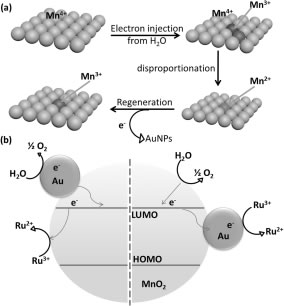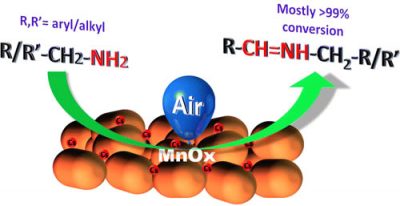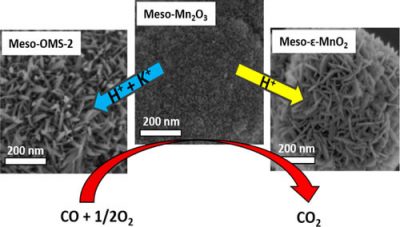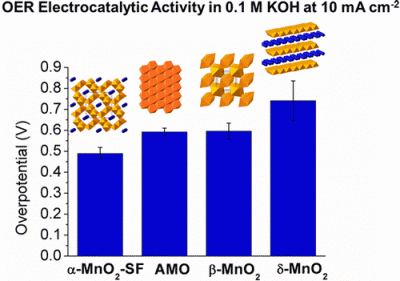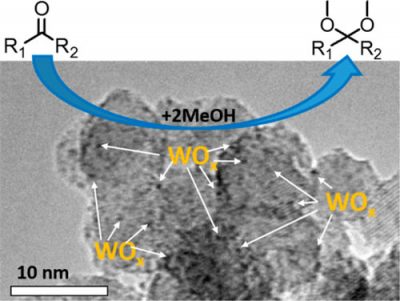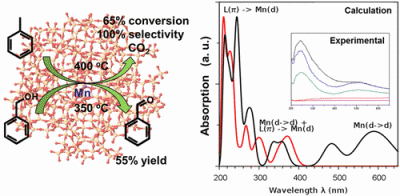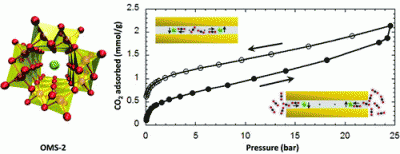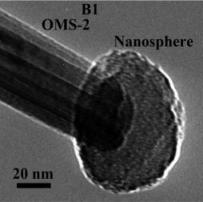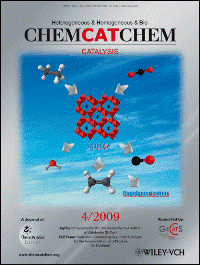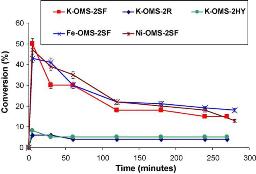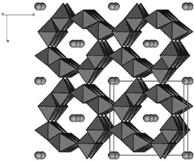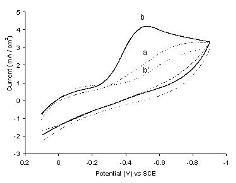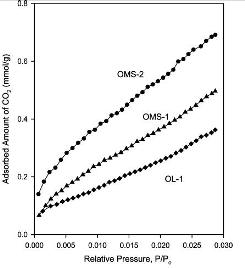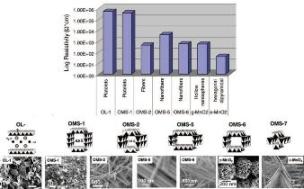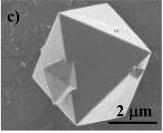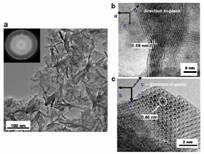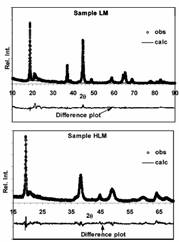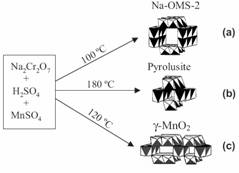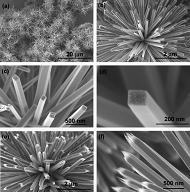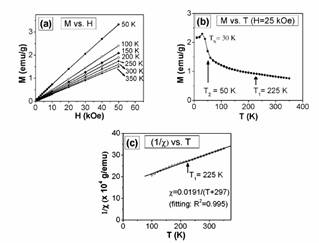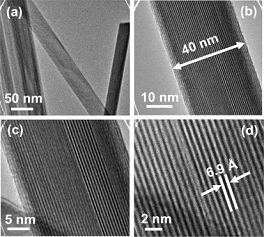|
Understanding the role of gold nanoparticles in enhancing the catalytic activity of manganese oxides in water oxidation reactions |
|
|
|
The Earth-abundant and inexpensive manganese oxides (MnOx) have emerged as an intriguing type of catalysts for the water oxidation reaction. However, the overall turnover frequencies of MnOx catalysts are still much lower than that of nanostructured IrO2 and RuO2 catalysts. Herein, we demonstrate that doping MnOx polymorphs with gold nanoparticles (AuNPs) can result in a strong enhancement of catalytic activity for the water oxidation reaction. It is observed that, for the first time, the catalytic activity of MnOx/AuNPs catalysts correlates strongly with the initial valence of the Mn centers. By promoting the formation of Mn3+ species, a small amount of AuNPs (< 5%) in a-MnO2/AuNP catalysts significantly improved the catalytic activity up to 8.2 times in the photochemical and 6 times in the electrochemical system, compared with the activity of pure a-MnO2. |
|
[Angewandte Chemie International Edition, 2015, 54(8), 2345-2350] |
|
|
…………………………………………………………………………………………………………………………………………………………………… |
|
|
Efficient Aerobic Oxidation of Amines to Imines by Cesium Promoted Mesoporous Manganese Oxide
|
|
|
|
Selective oxidation of amines to imines is one of the most studied reactions in the field of heterogeneous catalysis. Cs ion promoted mesoporous manganese oxide (meso Cs/MnOx) was synthesized using inverse surfactant micelle as a soft template. The chemical and structural properties of the mesoporous manganese oxide material were characterized by powder X-ray diffraction (PXRD), nitrogen sorption, electron microscopy and X-ray photoelectron spectra (XPS). The meso-Cs/MnOx material presented aggregated nanocrystalline nature with monomodal mesoporous size distributions. The catalyst was found to be effective in oxidation of amines to imines under aerobic conditions. The meso Cs/MnOx exhibited oxidation of primary, secondary, cyclic, aromatic, and aliphatic amines to imines, where the conversions reached as high as >99%. The catalyst was also effective in oxidative cross condensation of two different amines to produce asymmetrically substituted imines. Surface active Mn3+ species along with labile lattice oxygen were found to play an important role in the catalytic activity. Mild reaction conditions (air atmosphere and absence of any oxidative or basic promoters), ease of product separation by simple filtration and significant reusability make this mesoporous manganese oxide material an economical and ecofriendly catalyst for the syntheses of versatile imine derivatives.
|
|
[ACS Catalysis, 2015, 5 (7), 4394–4403] |
|
|
…………………………………………………………………………………………………………………………………………………………………… |
|
|
Crystalline Mesoporous K2-XMn8O16 and ε‑MnO2 by Mild Transformation of Amorphous Manganese Oxide and Their Enhanced Redox Properties
|
|
|
|
Synthesis of crystalline mesoporous K2–xMn8O16 (Meso-OMS-2), and ε-MnO2 (Meso-ε-MnO2) is reported. The synthesis is based on the transformation of amorphous mesoporous manganese oxide (Meso-Mn-A) under mild conditions: aqueous acidic solutions (0.5 M H+and 0.5 M K+), at low temperatures (70 °C), and short times (2 h). Meso-OMS-2 and Meso-ε-MnO2 maintain regular mesoporosity (4.8–5.6 nm) and high surface areas (as high as 277 m2/g). The synthesized mesoporous manganese oxides demonstrated enhanced redox (H2-TPR) and catalytic performances (CO oxidation) compared to nonporous analogues. The order of reducibility and enhanced catalytic performance of the samples is Commercial-Mn2O3 < nonporous-OMS-2 < Meso-Mn2O3 < Meso-OMS-2 < Meso-ε-MnO2 < Meso-Mn-A. |
|
[Appl. Mater. Interfaces, 2014, 6, 10986-10991.] |
|
|
…………………………………………………………………………………………………………………………………………………………………… |
|
|
Structure–Property Relationship of Bifunctional MnO2 Nanostructures: Highly Efficient, Ultra-Stable Electrochemical Water Oxidation and Oxygen Reduction Reaction Catalysts Identified in Alkaline Media
|
|
|
|
Manganese oxides of various structures (α-, β-, and δ-MnO2 and amorphous) were synthesized by facile methods. The electrocatalytic properties of these materials were systematically investigated for catalyzing both oxygen evolution reaction (OER) and oxygen reduction reaction (ORR) in alkaline media. Extensive characterization was correlated with the activity study by investigating the crystal structures (XRD, HRTEM), morphologies (SEM), porosities (BET), surfaces (XPS, O2-TPD/MS), and electrochemical properties (Tafel analysis, Koutechy–Levich plots, and constant-current electrolysis). These combined results show that the electrocatalytic activities are strongly dependent on the crystallographic structures, and follow an order of α-MnO2 > AMO > β-MnO2 > δ-MnO2. Both OER studies and ORR studies reveal similar structure-determined activity trends in alkaline media. In the OER studies, α-MnO2 displays an overpotential of 490 mV compared to 380 mV shown by an Ir/C catalyst in reaching 10 mA cm–2. Meanwhile, α-MnO2 also exhibits stability for 3 h when supplying a constant current density of 5 mA cm–2. This was further improved by adding Ni2+ dopants (ca. 8 h). The superior OER activity was attributed to several factors, including abundant di-μ-oxo bridges existing in α-MnO2 as the protonation sites, analogous to the OEC in PS-II of the natural water oxidation system; the mixed valencies (AOS = 3.7); and the lowest charge transfer resistances (91.8 Ω, η = 430 mV) as revealed from in situ electrochemical impedance spectroscopy (EIS). In the ORR studies, when reaching 3 mA cm–2, α-MnO2 shows 760 mV close to 860 mV for the best ORR catalyst (20% Pt/C). The outstanding ORR activity was due to the strongest O2 adsorption capability of α-MnO2 suggested by temperature-programmed desorption. As a result, this discovery of the structure-related electrocatalytic activities could provide guidance in the further development of easily prepared, scalable, and low-cost catalysts based on metal oxides and their derivatives. |
|
[Journal of the American Chemical Society 2014, 136 (32), 11452-11464] |
|
|
…………………………………………………………………………………………………………………………………………………………………… |
|
|
Tungsten-Promoted Mesoporous Group 4 (Ti, Zr, and Hf) Transition-Metal Oxides for Room-Temperature Solvent-Free Acetalization and Ketalization Reactions
|
|
|
|
Tungsten (0–30%)-promoted University of Connecticut mesoporous materials (UCT-X, X = 55 (Ti), 50 (Zr), and 56 (Hf)) were synthesized in one step using a recently discovered approach. The approach relies on inverse micelle formation and unique NOx chemistry to control the sol–gel chemistry of inorganic components. The tungsten-promoted mesoporous transition-metal (TM) oxides consist of monodispersed nanocrystalline particle aggregates with a particle size of ∼12 nm. The mesopores are formed by connected intraparticle voids of these aggregates, and the pore sizes vary between 3.8 and 6.1 nm, depending on the tungsten loading and TM oxide support. The materials were closely examined using PXRD, HRTEM, XPS, FTIR, Raman, and N2 sorption. The tungsten exist as very small (<1 nm) nano-WOxclusters that are well-dispersed on the TM support. Nano-WOx clusters were found to promote the formation of Brønsted acid sites. Catalytic activity was tested for solvent-free room-temperature acetalization and ketalization reactions. A 20% tungsten loading was found to be the optimum loading for the reactions. The catalyst can convert benzaldehyde with a conversion of 99% and yield of 93% to the corresponding acetal and can convert cyclohexanone with a conversion of 96% and yield of 94% to the corresponding ketal. The strong adsorption of products and intermediates on the mesopores was found to be the reason for the moderate performance in the conversion of other substrates. |
|
[Chemistry of Materials 2014 26 (9), 2803-2813] |
|
|
…………………………………………………………………………………………………………………………………………………………………… |
|
|
One-Step Hydrothermal Synthesis of Manganese-Containing MFI-Type Zeolite, Mn–ZSM-5, Characterization, and Catalytic Oxidation of Hydrocarbons
|
|
|
|
Manganese-containing MFI-type Mn–ZSM-5 zeolite was synthesized by a facile one-step hydrothermal method using tetrapropylammonium hydroxide (TPAOH) and manganese(III)-acetylacetonate as organic template and manganese salts, respectively. A highly crystalline MFI zeolite structure was formed under pH = 11 in 2 days, without the need for additional alkali metal cations. Direct evidence of the incorporation of Mn in the zeolite framework sites was observed by performing structure parameter refinements, supported by data collected from other characterization techniques such as IR, Raman, UV–vis, TGA, N2-adsorption, SEM, TEM, EDAX, and XPS. UV–vis spectra from the unique optical properties of Mn–ZSM-5 show two absorption peaks at 250 and 500 nm. The absorption varies in different atmospheres accompanied by a color change of the materials due to oxygen evolution. Raman spectra show a significant and gradual red shift from 383 cm–1 to 372 cm–1 when the doping amount of Mn is increased from 0 to 2 wt %. This suggests a weakened zeolite structural unit induced by the Mn substitution. The catalytic activity was studied in both gas-phase benzyl alcohol oxidation and toluene oxidation reactions with remarkable oxidative activity presented for the first time. These reactions result in a 55% yield of benzaldehyde, and 65% total conversion of toluene to carbon dioxide for the 2% Mn–ZSM-5. Temperature programmed reduction (TPR) using CO in He demonstrates two reduction peaks: one between 300 and 500 °C and the other between 500 and 800 °C. The first reduction peak, due to manganese-activated oxidation sites shifted from higher temperature to lower temperature, and the peak intensity of CO2 rises when the dopant amount increases. For the first time, calculated photophysical properties of a model Mn(O-SiH3)4– compound, an Mn-embedded zeolite cluster, and model Mn oxides help to explain and interpret the diffuse reflectance spectroscopy of Mn–ZSM-5 zeolites. |
|
[Journal of the American Chemical Society 2013, 135 (23),8594-8605] |
|
|
…………………………………………………………………………………………………………………………………………………………………… |
|
|
Time-Dependent CO2 Sorption Hysteresis in a One-Dimensional Microporous Octahedral Molecular Sieve
|
|
|
|
The development of sorbents for next-generation CO2 mitigation technologies will require better understanding of CO2/sorbent interactions. Among the sorbents under consideration are shape-selective microporous molecular sieves with hierarchical pore morphologies of reduced dimensionality. We have characterized the non-equilibrium CO2 sorption of OMS-2, a well-known one-dimensional microporous octahedral molecular sieve with manganese oxide framework. Remarkably, we find that the degree of CO2 sorption hysteresis increases when the gas/sorbent system is allowed to equilibrate for longer times at each pressure step. Density functional theory calculations indicate a “gate-keeping” role of the cation in the tunnel, only allowing CO2 molecules to enter fully into the tunnel via a highly unstable transient state when CO2 loadings exceed 0.75 mmol/g. The energy barrier associated with the gate-keeping effect suggests an adsorption mechanism in which kinetic trapping of CO2 is responsible for the observed hysteretic behavior. |
|
[J. Am. Chem. Soc. 2012, 134, 7944-7951] |
|
|
…………………………………………………………………………………………………………………………………………………………………… |
|
|
Manganese Oxide Octahedral Molecular Sieves (OMS-2) Multiple Framework Substitutions: A New Route to OMS-2 Particle Size and Morphology Control
|
|
|
Self-assembled multidoped cryptomelane hollow microspheres with ultrafi ne particles in the size range of 4–6 nm, and with a very high surface area of 380 m 2 g − 1 have been synthesized. The particle size, morphology, and the surface area of these materials are readily controlled via multiple framework substitutions. The X-ray diffraction and transmission electron microscopy (TEM) results indicate that the as-synthesized multidoped OMS-2 materials are pristine and crystalline, with no segregated metal oxide impurities. These results are corroborated by infrared (IR) and Raman spectroscopy data, which show no segregated amorphous and/or crystalline metal impurities. The fi eld-emission scanning electron microscopy (FESEM) studies confi rm the homogeneous morphology consisting of microspheres that are hollow and constructed by the self-assembly of pseudo-fl akes, whereas energy-dispersive X-ray (EDX) analyses imply that all four metal cations are incorporated into the OMS-2 structure. On the other hand, thermogravimetric analyses (TGA) and differential scanning calorimetry (DSC) demonstrate that the as-synthesized multidoped OMS-2 hollow microspheres are more thermally unstable than their single-doped and undoped counterparts. However, the in-situ XRD studies show that the cryptomelane phase of the multidoped OMS-2 hollow microspheres is stable up to about 450 ° C in air. The catalytic activity of these microspheres towards the oxidation of diphenylmethanol is excellent compared to that of undoped OMS-2 materials. |
|
|
[Advanced Functional Materials (2011), 21, 312-323] |
|
|
…………………………………………………………………………………………………………………………………………………………………… |
|
|
Removal of Aqueous Phenol by Adsorption and Oxidation with Doped Hydrophobic
Cryptomelane-Type Manganese Oxide (K-OMS-2) Nanofibers |
|
|
|
Molecular adsorption and oxidation at manganese oxide/liquid interfaces has attracted increased interest due to its importance in the development of heterogeneous catalysts, microbial fuel cells, and selective adsorption materials. Here we report the adsorption and oxidation of phenolic compounds on Cu2+, Co3+, and Ce4+ doped K-OMS-2 nanofibers. Different metal ion doped K-OMS-2 catalysts show distinct adsorption and oxidation ability. The structure and compositions of doped K-OMS-2 catalysts were characterized by X-ray diffraction and atomic absorption analyses. The relationships of catalyst structure-catalytic properties were discussed. The adsorbed polymeric nanospheres on doped K-OMS-2 nanofibers were investigated by field emission scanning electron microscopy, Fourier transform infared spectroscopy, transmission electron microscopy, and energy dispersive X-ray analyses. These nanospheres were totally oxidized to CO2 in oxygen or air at 553-603 K catalyzed by doped and undoped K-OMS-2 itself. OMS-2 was regenerated with air or oxygen. The chemisorption and oxidation of phenol in an anaerobic environment (N2) demonstrate that lattice oxygen of cryptomelane is involved in these processes. Free-radical mechanisms are proposed for the oxidation of phenol in O2 and for the formation of phenolic nanospheres. Compared with undoped K-OMS-2, metal ion doped K-OMS-2 shows higher adsorption capacity of phenolic compounds and higher phenol removal rate. |
|
[ J. Phys. Chem. C (2010), XXX, 000, early view] |
|
|
…………………………………………………………………………………………………………………………………………………………………… |
|
|
Dehydrogenation of Ethane in the Presence of CO2 over Octahedral Molecular Sieve (OMS-2) Catalysts (Cover Story)
|
|
|
|
Using OMS-2 as the catalyst in C2H6 dehydrogenation in the presence of CO2, is an example where extreme conditions are used to drive high conversions of ethane (>70 %) and CO2 (up to 56 %) with high selectivity towards ethylene (87 %) with a short contact time (0.6 s) . The reaction pathway involved two steps: ethane catalytic dehydrogenation and a reverse water- gas shift reaction. High ethylene yields (66 %) were obtained and could be improved by using OMS- 2 as an active support. This inexpensive material also showed high stability during the process, and the presence of CO2 removed coke depositions throughout the catalyst. Such impressive activity, selectivity, and stability open up new possibilities for olefin dehydrogenations in the presence of CO2, a perfect feedstock for any process involving ethylene carbonylation with the recycling of the greenhouse gas. |
|
[ ChemCatChem 2009, 1, (4), 441-444 ] |
|
|
…………………………………………………………………………………………………………………………………………………………………… |
|
|
Improved process for oxidative dehydrogenation of ethane and related reactions |
|
|
The invention relates to a method for producing a mixt. of ethylene and carbon monoxide by contacting ethane and carbon dioxide with a catalyst comprising synthetic cryptomelane or octahedral mol. sieve. The invention also provides reactions of ethylene and carbon monoxide with an alc. to produce an alkyl propionate, which can further react with formaldehyde to produce an alkyl methacrylate. |
|
|
[Eur. Pat. Appl. ( 2010 ), EP 2165997 A1 20100324] |
|
|
…………………………………………………………………………………………………………………………………………………………………… |
|
|
Nanoscale manganese oxide octahedral molecular sieves (OMS-2) as efficient photocatalysts in 2-propanol oxidation
|
|
|
|
Cryst. tunnel structure cryptomelane type manganese oxides (OMS- 2) have been studied as photocatalysts for the selective oxidn. of 2- propanol to acetone. The reaction is carried out with visible light irradn. at room temp. The activities of various K- OMS- 2 and metal doped OMS- 2 (M- OMS- 2) catalysts prepd. by different synthesis procedures have been evaluated. K- OMS- 2 and M- OMS- 2 (M = Fe, Ni) with nanorod morphol. were the most active photocatalysts. Conversions obtained for these catalysts ranged from 50 to 15 %. K- OMS- 2 fibers gave only 5- 6 % conversion. All reactions gave 100 % selectivity to acetone. The reusability of the K- OMS- 2 catalyst was also tested. Characterization of K- OMS- 2 catalysts was done using several techniques like temp. programmed desorption, UV- vis spectroscopy, av. oxidn. state anal., XRD, BET and FE- SEM. As suggested by the photochem. and characterization data, synthesis methodol., morphol., mixed valency and the release of oxygen from the OMS- 2 structure are important factors for the design of active OMS- 2 photocatalysts. XRD and FTIR were also used to study structural changes in the catalyst after photolysis. |
|
[ Applied Catalysis, A: General 2010, 375, (2), 295-302 ] |
|
|
…………………………………………………………………………………………………………………………………………………………………… |
|
|
Synthesis, Characterization, and Rietveld Refinement of Tungsten-Framework-Doped Porous Manganese Oxide (K-OMS-2)
|
|
|
|
Tungsten was successfully doped at 1 and 2 mol % tungsten into the K-OMS-2 framework. Sodium tungstate and tungsten pentabromide were used in a reflux synthesis preparation. The data collected from the characterization methods collectively affirm the substitution of tungsten into the K-OMS-2 framework. Conductivity measurements showed an increase in the resistivity. Conversion of benzyl alcohol to benzaldehyde had a conversion of 25 and 15% for the sodium tungstate and tungsten pentabromide, respectively, while retaining 100% selectivity. Properties such as the resistivity, thermal stability, and crystallinity of the material were altered depending on the amount and type of starting reactants used. |
|
[ Chemistry of Materials ( 2008 ), 20(20), 6382-6388 ] |
|
|
…………………………………………………………………………………………………………………………………………………………………… |
|
|
Structure, porosity, and redox in porous manganese oxide octahedral layer and molecular sieve materials
|
|
|
|
The control of synthesis methods allows the preparation of unique materials such as octahedral layer (OL) and octahedral molecular sieve (OMS) systems. These mixed valent porous materials are excellent semiconductors. Conductivity in porous molecular sieve materials is unusual and leads to more favorable characterization such as less charging in relation to insulating materials like clays and zeolites. Semiconductivity of OL and OMS materials allows potential applications as sensors, redox catalysis, and in fuel cells. This review will focus on the use of composition and redox to control the structure, morphology, porosity, catalytic activity, and conductivity of such materials. A major emphasis in this field has been on the generation of new materials and the mechanism of formation of such systems. |
|
[J. Mater. Chem., 2008, 18, 1623–1631] |
|
|
…………………………………………………………………………………………………………………………………………………………………… |
|
|
Framework Doping of Indium in Manganese Oxide Materials: Synthesis, Characterization, and Electrocatalytic Reduction of Oxygen
|
|
|
|
Indium-doped manganese oxide materials have been hydrothermally synthesized. Doped indium was found to be in framework sites in synthetic cryptomelane, based on the results of XRD, average oxidation state (AOS) of manganese, Raman, and IR. TEM images show that indium-free OMS-2 and K-In-OMS-2(R=1/5) have a morphology of nanorods. Cyclic voltammetry (CV) was used to test the electrocatalytic activity in the oxygen reduction. CV results show that manganese oxide doped with indium generates electrocatalytic activity for the O 2 reduction reaction. |
|
[Chemistry of Materials (2008), 20(6), 2069-2071] |
|
|
…………………………………………………………………………………………………………………………………………………………………… |
|
|
Adsorptive and Acidic Properties, Reversible Lattice Oxygen Evolution, and Catalytic Mechanism of Cryptomelane-Type Manganese Oxides as Oxidation Catalysts
|
|
|
|
Cryptomelane-type manganese oxides have been synthesized, characterized, and tested in the total oxidation of volatile organic compounds and CO oxidation. The structural, compositional, morphological, acid-base, physisorptive-chemisorptive, and thermal stability properties (especially the reversible evolution of lattice oxygen) have been studied in detail using ICP-AES, HRSEM, XRD, IR and adsorbate-IR, N2 and CO2physisorption at 77 and 273 K, respectively, TPD-MS, and TGA-DSC techniques. Kinetic and mechanistic studies for the catalytic function have been conducted and related to the characterization results. Cryptomelane has shown to be highly microporous, by using CO2 physisorption, and highly hydrophobic, possessing both Bro¨nsted and Lewis acid sites. A part of the lattice oxygen atoms can be reversibly removed from the framework and recovered at elevated temperature without changing the framework structure. These lattice oxygen atoms can react with CO even at room temperature and are active sites for the oxidation of benzene. The consumed lattice oxygen atoms are replenished by gaseous oxygen to complete a catalytic cycle. The ease of reversible evolution of lattice oxygen, together with the high porosity, hydrophobicity, and acidity, leads to the excellent oxidation |
|
[Journal of the American Chemical Society (2008), 130(10), 3198-3207] |
|
|
…………………………………………………………………………………………………………………………………………………………………… |
|
|
Porous Manganese Oxide Octahedral Molecular Sieves and Octahedral Layered Materials
|
|
|
|
This Account first gives a historical overview of the development of octahedral molecular sieve (OMS) and octahedral layer (OL) materials based on porous mixed-valent manganese oxides. Unique properties of such systems include excellent semiconductivity and porosity. Materials that are conducting and porous are rare and can offer novel properties not normally available with most molecular sieve materials. The good semiconductivity of OMS and OL systems not only permits potential applications of the conductivity of these materials but also allows characterization of these systems where charging effects are often a problem. Porous manganese oxide natural materials are found as manganese nodules, and these materials when dredged from the ocean floors have been used as excellent adsorbents of metals such as from electroplating wastes and have been shown to be excellent catalysts. Rational for synthesis of novel OMS and OL materials is related to the superb conductivity, microporosity, and catalytic activity of these natural materials. |
|
[Accounts of Chemical Research (2008), 41(4), 479-487] |
|
|
…………………………………………………………………………………………………………………………………………………………………… |
|
|
Shape Evolution of Single-Crystalline Mn2O3 Using a Solvothermal Approach
|
|
|
|
A new and facile route was developed to manipulate the growth of hierarchically ordered Mn2O3 architectures via a solvothermal approach. Various solvents are employed to control the product morphologies and structures. Mn2O3 with unique cuboctahedral, truncated-octahedral, and octahedral shapes are obtained, and a possible formation mechanism is proposed.
|
|
[J. Phys. Chem. C, 2007, 111, 14694-14697] |
|
|
…………………………………………………………………………………………………………………………………………………………………… |
|
|
Colloidal Manganese Oxide Precursor to Octahedral Layered, OL-3 Materials |
|
|
|
This study reports one-pot synthesis of a hexagonal form of a layered manganese oxide material (OL-3) using mild conditions and low temperature. The oxidation of an aqueous solution of manganese acetate using tetramethylammonium hydroxide and hydrogen peroxide at 4 °C leads to the formation of a colloidal manganese dioxide solution. Colloidal MnO2 was then flocculated using K ions, forming disordered layered manganese oxide nano-flakes. The results indicate that the colloidal manganese oxide nano-flakes flocculated into ultra-thin, disorderly-stacked hexagonal lamellar sheets composed of a material with the chemical composition of K1.04MnO2.340.6H2O.
|
|
[Journal of Inorganic and Organometallic Polymers and Materials, 2007, 17(2), 459-467] |
|
|
…………………………………………………………………………………………………………………………………………………………………… |
|
|
Characterization and Electrocatalytic Behavior of Layered Li2MnO3 and Its Acid-Treated Form |
|
|
|
The material H[H0.18Li0.15Mn0.67]O1.90, obtained by the delithiation of layered Li2MnO3 using acid, gives a 2-fold increase in oxygen reduction ability versus Li2MnO3. Using elemental analysis by the ICP technique, average oxidation state determination, acid-base titrations, and thermal analysis, we determined the chemical composition of the proton-exchanged material to be H[H0.18Li0.15Mn0.67]O1.90. Rietveld refinement shows that the structure of the delithiated material is a monoclinic distortion of the P 3 structure resulting in the C 2/ mspace group with cell parameters a) 5.049(2) Å, b ) 8.707(2) Å, c ) 4.903(1) Å, â ) 109.17(2)°. The BET surface area for the materials increases from 18 to 57 m2/g upon delithiation. Application of H[H0.18Li0.15Mn0.67]O1.90, as an electrocatalyst in a lithium-air cell gives a specific discharge capacity of 1618 mAh g-1. |
|
[Chem. Mater. 2007, 19, 229-234] |
|
|
…………………………………………………………………………………………………………………………………………………………………… |
|
|
Process for the preparation of arylimines via conversion of hydroxyl groups to carbonyl groups using porous manganese-based octahedral mol. sieves. |
|
|
A method for forming an imine comprises reacting a first reactant comprising a hydroxyl functionality, a carbonyl functionality, or both a hydroxyl functionality and a carbonyl functionality with a second reactant having an amine functionality in the presence of ordered porous manganese-based octahedral molecular sieves and an oxygen containing gas at a temperature and for a time sufficient for the imine to be produced. |
|
|
[U.S. Pat. Appl. Publ., 2007, US 2007027344 , 10pp.] |
|
|
…………………………………………………………………………………………………………………………………………………………………… |
|
|
Hydrothermal synthesis of structure- and shape-controlled manganese oxide octahedral molecular sieve nanomaterials |
|
|
|
Highly uniform single-crystal Na-OMS-2 (OMS: octahedral molecular sieve), pyrolusite, and c-MnO 2 nanostructures with an interesting 3D urchinlike morphology have been successfully prepared using a hydrothermal method based on a mild and direct reaction between sodium dichromate and manganese sulfate. The crystal phases, shapes, and tunnel sizes of the manganese dioxide nanostructures can be tailored. Reaction temperature, concentrations of the reactants, and acidity of the solution play important roles in controlling the synthesis of these manganese dioxides. Field-emission scanning electron microscopy and transmission electron microscopy (TEM) studies show that the nanomaterials obtained are constructed of self-assembled nanorods. X-ray diffraction and TEM results indicate that the constituent manganese dioxide particles are single-crystalline materials. Energy dispersive X-ray analysis and magnetic studies imply that chromium cations may be incorporated into the framework and/or tunnels of the manganese dioxides. A mechanism for the growth of manganese dioxides with urchinlike architectures is proposed. |
|
[Advanced Functional Materials, 2006, 16(9), 1247-1253] |
|
|
…………………………………………………………………………………………………………………………………………………………………… |
|
|
In situ Synthesis of Mixed-Valent Manganese Oxide Nanocrystals: An In situ Synchrotron X-ray Diffraction Study |
|
|
|
In situ characterizations of phase transformations by in situ synchrotron powder X-ray diffraction was successfully performed for wet chemistry systems at different pH media. Quartz capillary tubes are brittle for high temperature/basic systems. The sapphire capillary tube is robust for pressurized, acidic, and basic conditions. In situ synchrotron XRD studies provide an opportunity for better control of material syntheses, which is difficult to achieve for conventional kinetic study methods as also suggested by others. For example, different surface areas for a pure KOMS-2 phase and varying tunnel structures of manganese oxides can be controlled in studies here. This method is not limited to manganese oxides but can be used for in situ characterization of other materials during synthesis using hydrothermal, sol-gel, or other methods. In addition, catalytic processes in liquid-solid, gas-solid, or solid-solid systems can also be studied in an in situ way. Combined with Rietveld refinement, oxygen/cation vacancies or defects in the catalyst structure can be investigated for a better understanding of the catalytic mechanisms. As a result, catalyst synthesis and catalytic processes can be optimized. |
|
[J. Am. Chem. Soc., 2006, 128 (14), 4570 -4571] |
|
|
…………………………………………………………………………………………………………………………………………………………………… |
|
|
Synthesis of Single Crystal Manganese Oxide Octahedral Molecular Sieve (OMS) Nanostructures with Tunable Tunnels and Shapes |
|
|
|
A new and facile route is reported to manipulate the self-assembly synthesis of hierarchically ordered Rb-OMS-2 and pyrolusite with an interesting flowerlike morphology by a direct and mild reaction between rubidium chromateand manganese sulfate without any organic templates. The crystal forms, morphologies, and tunnel sizes of the obtained OMS materials can be controlled. A mechanism for the growth of manganese dioxides with flowerlike architectures was proposed. The obtained products exhibit potential for use in catalysis and other applications. |
|
[Journal of Physical Chemistry B, 2006, 110(7), 3066-3070] |
|
|
…………………………………………………………………………………………………………………………………………………………………… |
|
|
Magnetic Route to Measure the Average Oxidation State of Mixed-Valent Manganese in Manganese Oxide Octahedral Molecular Sieves (OMS) |
|
|
|
A magnetic route has been successfully applied to determine the AOS of both mixed-valent framework Mn and single oxidation states of Mn in manganese oxide OMS. The results from the magnetic method are in good agreement with titration results. The magnetic route confirms that framework manganese in KOMS-2 and OMS-6 is mixed-valent, consisting of 3+ and 4+ with Mn3+ in the low spin state. Magnetic methods can be used for identification of minor/impurity phases in paramagnetic or ferromagnetic samples as also pointed out by Wold. The requirements are that (1) the systems should show Curie-Weiss behavior over a temperature range and (2) there are no more than two paramagnetic ions present. |
|
[Journal of the American Chemical Society, 2005, 127(17), 6166-6167] |
|
|
…………………………………………………………………………………………………………………………………………………………………… |
|
|
Shape-Controlled Synthesis of Manganese Oxide Octahedral Molecular Sieve Three-Dimensional Nanostructures |
|
|
|
This study reports the fabrication of ordered porous manganese oxide paper-like free standing membranes (FSMs) by simply heating “pulp” -like homogeneous suspensions at low temperatures. These free-standing membranes are robust and flexible, and can be formed on a patterned substrate in order to make micropatterns. Tangled manganese oxide nanowires in suspension aggregate and align systematically to form such membranes. The paper-like membranes is composed of single-crystal cryptomelane-type manganese oxide (OMS-2) fibers. The outstading features of this system include the unusual mechanical properties, periodicity, facile preparation, conductivity, easy of ion-exchange, malleability, and diffusional properties, which are due to the formation of hierarchical porous structures. |
|
[Advanced Materials ( Weinheim , Germany ), 2004, 16(19), 1729-1732] |
|
|
…………………………………………………………………………………………………………………………………………………………………… |
|
|
Synthesis, characterization, and catalytic applications of manganese oxide octahedral molecular sieve (OMS) nanowires with a 2 x 3 tunnel structure |
|
|
|
Romanechite is a natural manganese oxide with a 2×3 tunnel structure containing a majority of Ba 2+ and trace amounts of Na+ , K+ , and Sr2+ as tunnel cations. Many attempts have been made to synthesize the 2×3 tunnel structured manganese oxide in laboratories using Ba 2+ as the template. However, no successful work has been reported due to (1) the presence of intergrown hollandite impurities (barium-2 x 2 tunnel structure manganese oxide) in the synthesized products and (2) the absence of romanechite characteristic X-ray diffraction (XRD) peaks in the products, such as the (001) and (200) diffraction peaks which correspond to d = 9.7 and 7.0 Å, respectively. Hydrated Na + ions have been utilized as structure directors to successfully synthesize the Na + 2 x 3 tunnel structure manganese oxide (OMS-6) from hydrothermal treatment of Na-birnessite. XRD gave a pattern in very good agreement with the pattern of romanechite (JCPDS file 14-627) without impurity phases. High-resolution microscopy measurements showed a nanofibrous morphology of the materials with an average fiber diameter of 40 nm. Under N 2 environments, the 2 x 3 tunnel structure is stable below 550 °C and transforms into hausmannite (Mn 3 O 4 ) at temperatures of 550 °C or higher; however, under O2 environments, the 2 x 3 tunnel structure is preserved at 550 °C as measured by in situ XRD. The density functional theory (DFT) method indicated that the 2 x 3 tunnel structure has a major micropore size of 7.5 Å. NH 3 and CO 2 chemisorption results indicated that the amount of strong acidic and basic sites on the Na-2 _ 3 material is about 0.22 and 0.002 mmol/g sample, respectively. Catalytic oxidation of indene by the Na-2×3 manganese oxide showed a 96% conversion for indene and a 73% selectivity toward phthalic anhydride for a 40 h reaction at 80 °C. |
|
[Chemistry of Materials, 2004, 16(25), 5327-5335] |
|
